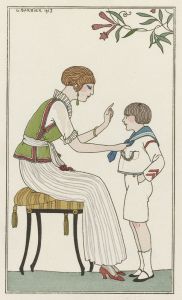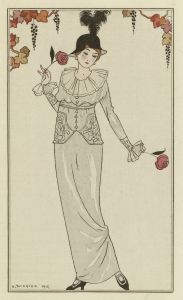
Journal des Dames et des Modes, Costumes Parisiens, 1914, No. 162
A hand-painted replica of Gerda Wegener’s masterpiece Journal des Dames et des Modes, Costumes Parisiens, 1914, No. 162, meticulously crafted by professional artists to capture the true essence of the original. Each piece is created with museum-quality canvas and rare mineral pigments, carefully painted by experienced artists with delicate brushstrokes and rich, layered colors to perfectly recreate the texture of the original artwork. Unlike machine-printed reproductions, this hand-painted version brings the painting to life, infused with the artist’s emotions and skill in every stroke. Whether for personal collection or home decoration, it instantly elevates the artistic atmosphere of any space.
Gerda Wegener was a Danish illustrator and painter known for her work in the early 20th century, particularly her contributions to fashion magazines and her vibrant Art Deco style. One of her notable works is the illustration for "Journal des Dames et des Modes, Costumes Parisiens, 1914, No. 162." This piece is part of a series of fashion illustrations that Wegener created for the French fashion magazine "Journal des Dames et des Modes," which was a prominent publication during that era, showcasing the latest trends in Parisian fashion.
The "Journal des Dames et des Modes" was established in 1797 and became an influential fashion magazine that featured detailed illustrations of contemporary clothing styles. By the time Wegener contributed to it in 1914, the magazine was known for its high-quality illustrations that captured the elegance and sophistication of Parisian fashion. Wegener's work for the magazine is characterized by her attention to detail, vibrant use of color, and the graceful portrayal of women, reflecting the fashion and cultural aesthetics of the time.
In "Costumes Parisiens, 1914, No. 162," Wegener's illustration likely depicts a fashionable woman dressed in the latest Parisian style, as was typical for the magazine's content. Her illustrations often featured elongated figures and a sense of movement, embodying the Art Deco style that was gaining popularity. The clothing would have been depicted with precision, highlighting the textures and patterns that were in vogue during the period.
Wegener's contribution to the "Journal des Dames et des Modes" is significant as it showcases her skill as a fashion illustrator and her ability to capture the essence of early 20th-century fashion. Her work not only provided a visual record of the clothing styles of the time but also contributed to the broader cultural appreciation of fashion as an art form. The illustrations served as both a source of inspiration for contemporary fashion enthusiasts and a historical document for future generations interested in the evolution of fashion.
Gerda Wegener's career extended beyond fashion illustration; she was also known for her portraits and paintings, often featuring her spouse, Lili Elbe, who was one of the first known recipients of gender confirmation surgery. Wegener's work has gained renewed interest in recent years, both for its artistic merit and its connection to the story of Lili Elbe, which was depicted in the film "The Danish Girl."
Overall, Gerda Wegener's illustration for "Journal des Dames et des Modes, Costumes Parisiens, 1914, No. 162" is a testament to her talent and her role in the world of fashion illustration during a vibrant period in art and fashion history. Her work continues to be celebrated for its beauty, elegance, and historical significance.






